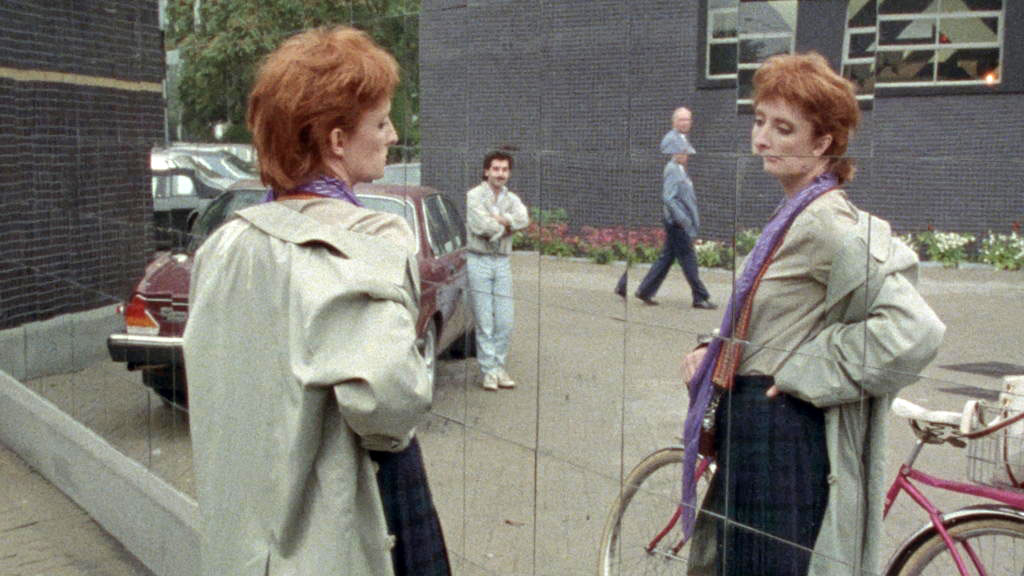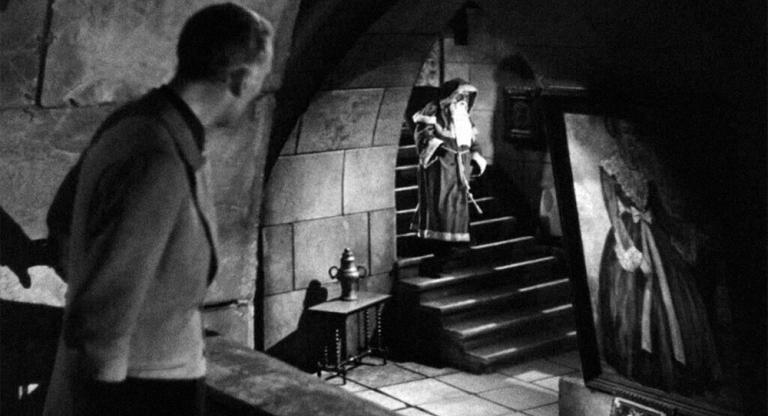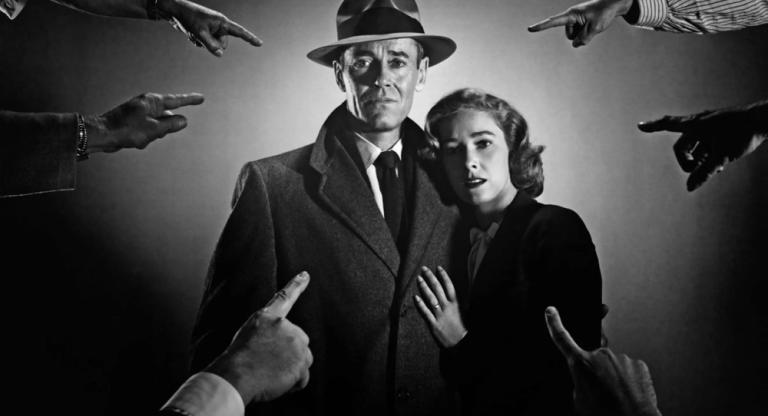A fixture of Canadiana which helped inaugurate the Toronto New Wave of the 1980s and 1990s, Patricia Rozema’s debut feature I’ve Heard the Mermaids Singing (1987) remains a monument of institutional and artistic cobbling: government grants, recommendation letters penned by the likes of David Cronenberg, accounts in overdraft, and $60 special effects. After premiering at Cannes (where it collected le Prix de la Jeunesse in the Director’s Fortnight), the film made back its budget nearly thirtyfold.
I’ve Heard the Mermaids Singing, which borrows its title from T. S. Eliot’s poem “The Love Song of J. Alfred Prufrock,” follows Polly Vandersma (Sheila McCarthy), an “organizationally impaired” girl Friday for a Toronto temp agency. Polly is an orphan and self-described spinster, unable to keep work for long in large part because of her inelegant, clumsy demeanor; she is also an amateur photographer, often clicking ordinary images of labor, romance, cityscapes, and developing them in her bathroom-cum-darkroom. Her images are embroidered affectionately into the film’s fabric through grainy, black-and-white freeze frames, and she commands the story through narration and direct-to-camcorder addresses.
When she is hired as a secretary for a prestigious art gallery under Gabrielle (Paule Baillargeon)—whom she dubs “The Curator” in voiceover—her own perceptions of art, refinement, and sexuality begin to rearrange themselves. Gabrielle is herself a painter and her parents bought her the gallery with the money they amassed through Swiss chocolate sales—a folkloric detail of her robust personal life which mesmerizes Polly, whose aspirations begin to crawl toward adoration. Polly remains clunky in every frame, absorbing too much space and never quite knowing what to do with her body, while Gabrielle seems to glide through the lens with an air of assurance.
Gabrielle represents a particular kind of artist: discerning and pretentious. She can spit quips like “thematically unresolved,” “boyish bravado,” and “oblique pragmatism” at a glance. Rozema is poking at the elitist, highbrow milieu of Toronto’s art scene (and arts criticism broadly) through The Curator, but also signifying the charms of manicured intelligentsia through Polly’s wide-eyed curiosity. After Polly helps erect an art piece of a mannequin with a TV concealing a camcorder for a head (a “surveillance sculpture” by Canadian visual artist Peter Dykhuis), she unwittingly spies on Gabrielle and her former lover Mary (Ann-Marie MacDonald).
As Mary re-enters Gabrielle’s life, Polly’s complicated feelings for her employer become increasingly lucid. Visual art becomes the medium by which these desires are exacted: Polly swipes one of Gabrielle’s “golden paintings” from her home and places it in the gallery (a series of identical canvases which appear to radiate warm, yellow light—a proxy for the affective potential of taking in artwork); later, she sends Gabrielle her photographs under a pseudonym, as a kind of love letter.
Once Gabrielle’s social currency rises when a passing art critic expresses his adoration of her golden painting in a newspaper review, Polly comes to realize the layers of artifice extant within the art world and her mentor’s practices. Where art is a site of pleasure and connection for her, the scene which Gabrielle occupies and concretizes is slick, brooding, and dishonest. In the summer of 2022, I spent an afternoon at Rozema’s Toronto home discussing I’ve Heard the Mermaids Singing, legitimacy in the art world, and queer longing.
Saffron Maeve: To begin, why T. S. Eliot and “Prufrock”? I heard that the working title was “Polly.”
Patricia Rozema: “Polly” was in my original file folder, and then it became “Oh, the Things I’ve Seen,” and we just called it “Oh.” But when I was casting about for a title, “The Love Song of J. Alfred Prufrock” was my favorite poem. I could quote vast swaths of it. Then it struck me—“I’ve heard the mermaids singing, each to each, I do not think that they will sing to me”—that minor character feeling, in a landscape where there is great beauty but it’s just inaccessible.
SM: Was the scene with the singing mermaids in it prior to that change?
PR: No, I adjusted the film to add that scene where they hear the mermaid singing. Though it was always about somebody who glimpses greatness, but they’re not allowed in. I thought that was heartbreaking and could be my life—I said, “Oh my god, if that’s my life, then I’m going to give that person some dignity. I’ll make them laughable so I don’t seem too earnest.”
SM: Double-edged sword.
PR: I had to live in a double universe in order to have the courage to make it, which is fine if you’re gay and closeted because you know all about double universes. Here’s your real life and here’s your other life, which is carefully constructed. I used that model to make the film I wanted to make, but would just tell people whatever they needed to hear for me in order to get it made.
SM: In that way, Polly is a bit of a cipher for you.
PR: Absolutely, but there’s also Mary in that story, who is the maker but can’t handle public recognition. Then Gabrielle, the curator, who is seduced by the praise and wants the status of having made a work of art that people respond to. Those two people are different selves, and so is Polly, but they’re all parts of myself.
SM: There’s a confessional, talking head quality to Polly in Mermaids that rhymes with your debut short Passion: A Letter in 16mm [1985]. Do you consider the film to be a continuation of Passion?
PR: Well, they both came from Grey Gardens [1975]. At one point, Little Edie addresses the camera and she’s in love with the cameraman. You’re looking into the eyes of this person who’s trying to seduce you, and you're feeling compromised as if you’re getting to see something that you shouldn’t, but you can’t look away. It was a bit of a trainwreck but I thought, whatever that is, it has power.
That was combined with Passion and the wish to be closeted. I envied love songs and love poems where you could just speak to the other and they don’t have to be seen, so I decided to do a love film, or a love letter, about a successful career woman. Then I thought, okay, now do an unsuccessful career woman: Polly. But the direct-to-camera address does connect Passion and Mermaids—it’s funny how you often make a film in reaction to your last.
SM: Well, you made White Room [1990] after this, which was another meditation on what it means to make art “authentically.” Why do you think you were drawn to questions of legitimate and illegitimate art at the very beginning of your career?
PR: That's a really good question. Do you have a theory?
SM: Curiosity, maybe? It’s easier to navigate a daunting industry if there are clear lines between what is and what isn’t, though this is obviously not always the case with film. I imagine that’s why I do arts criticism.
PR: You know, I bemoan the bypassing of criticism. Everything goes from the industry to the viewer now, without a lot of curation. I’ve had critics tell me what my film is about, or write about, and I go, that’s right! I could never have said that myself.
SM: That’s very encouraging.
PR: I’m fascinated with the examination of art, artists, subjectivity, and authenticity. Partly because I didn’t grow up in an artistic world at all. Not a single person I knew was in the arts—I was just fascinated by the impulse. What makes you want to take this feeling and experience and make something else of it? And do you know how flattering it is that a young, brilliant mind like yours wants to engage with this film from 35 years ago? What is it about Mermaids?
SM: For myself, personally? It was one of those films where I felt I saw my own conceptions of queer longing looking back at me. I recently read Julia Mendenhall’s book on the film, [I’ve Heard the Mermaids Singing: A Queer Film Classic], and she identifies this feeling as a kind of “stealth activism,” where the film is mobilizing its subtext. Like a step beyond identifying or aligning with a queer-coded character, but having something of a private correspondence with their image.
PR: [Mermaids] was at a time where there weren’t many queer representations, so I had to sneak past it to get to the mainstream audience. It’s not until 30 minutes in that there is any explicit queerness. I seduce you with Polly and lay all this other stuff on you. This came from watching My Beautiful Laundrette [1985], where you’re in their environment with all their problems, their chores, their people, and then, oh, they kiss each other!
SM: To what extent are we meant to read Polly’s naïveté as innocence or unrealized attraction? I’ve read academic texts which have described her as asexual.
PR: I did not think of her as asexual, but as pre-sexual—that this is almost like an adolescent dawning. She just felt like she could not find a connection. So maybe she’s queer and beginning to see it, because she’s certainly mesmerized by Gabrielle.
SM: “Love is a pretty strong word for another woman when you aren't talking about your mother.”
PR: I do think that yearning is the special sauce of every good movie.
SM: It’s the soft tissue of this movie, though I’ve seen Mermaids be described as not explicitly “queer enough.” How do you contend with that reading?
I mean, if you’re a lesbian from a Calvinist world, you’ve been written off so profoundly that it doesn’t really matter what you do. You’re a joke, you’re a mistake, you are a degenerate, you are not worth living from the get-go, so do whatever the hell you want. What you seek as a storyteller is a story that functions on a political, personal, economic, and gendered level. But it’s also your own little thing that you’re doing in front of people, hoping it’s disguised enough that you’re not mortified. I long to find those stories, the stories that you don’t need to be smart to understand—but for the people who love the layers and the references, there’s so much to chew on.
I’ve Heard the Mermaids Singing screens tonight, April 8, at Roxy as part of their “Patricia Rozema Retrospective.” Director Patricia Rozema will be in attendance for a Q&A.
CONTOURS is a column by Saffron Maeve examining films that thematize the world of visual art: heists, biopics, documentaries, and experimental fare. Maeve also programs a screening series of the same name and premise at Paradise Theatre in Toronto.



